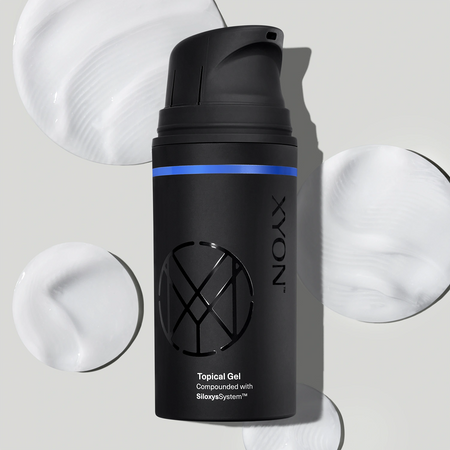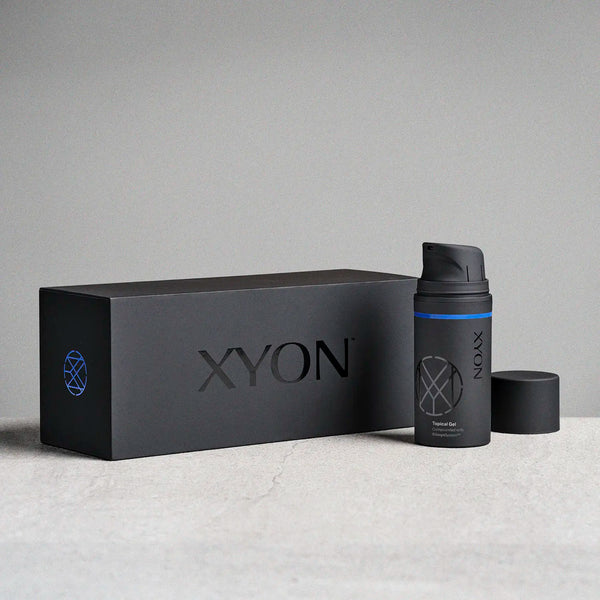Liposomal finasteride can be an effective medical treatment for hair loss. In this article, we'll discuss what liposomal finasteride gel is, how it works, the benefits of liposomal finasteride gel and the differences between different liposomal finasteride gel formulations.
Liposomal finasteride gel: What is it?
Liposomal finasteride gel is a type of compounded medicine used to treat hair loss. It combines finasteride, an FDA-approved drug for hair loss, with a certain type of topical vehicle called a liposomal gel.
Liposomal finasteride gel is applied directly to the scalp skin to target hair loss more directly than oral finasteride treatment. Topical treatments for hair loss like liposomal finasteride gel aim to maximize the effect on hair loss and reduce the medication’s side effect profile.
Our innovative gel features liposomal technology, to help ensure that medications get where they need to.


Looking for liposomal finasteride? XYON has your back.
How does liposomal finasteride gel work?
Liposomal finasteride gel works by transporting the active ingredient into cell membranes using liposomes to improve delivery of the drug within the scalp skin.
Liposomes are synthetic molecules with an outer lipid sheath. They were designed to act as vessels, carrying hydrophobic molecules past the lipid-based outer membrane of cells. Their composition allows them to permeate into cell membranes, which are lipid-based as well.

Medications like finasteride must be encapsulated within liposomes to increase their permeability. Active or passive methods can be employed to insert the active ingredient within liposomes. Liposomes containing finasteride are combined with water-based gels that can then be applied directly to areas affected by hair loss.
Benefits of liposomal finasteride gel
Drugs like finasteride can have difficulty permeating cell membranes without some help. Liposomal finasteride gel can help increase the degree of skin permeation within cellular membranes using liposomes.

This promotes greater uptake of the active ingredient, such as finasteride, within the scalp skin.
Scalp anatomy is rather complex. It contains many layers of tissue, hair follicles, nerves and blood vessels that act as passageways to the circulatory system. Liposomal finasteride gels can help to increase the drug’s effect within a certain layer of the skin or, more specifically, at the hair follicles.
Topical finasteride compounded without liposomes can still be effective. But the effects of finasteride can be enhanced by increasing drug permeation within the scalp skin. The addition of liposomes helps promote drug action at the hair follicles and improves uptake of the medication within the scalp skin.
Liposomal finasteride gel side effects
Liposomal gels can help to reduce the amount of finasteride that enters the bloodstream by increasing uptake within the scalp skin. With more of the active ingredient processed within the scalp skin, less makes its way into deeper layers of tissue that contain blood vessels. This effect can be enhanced by reducing the rate of movement into the body.
Liposomal finasteride gel formulations
When it comes to liposomal finasteride gel, not all formulations are equal. Liposomes help to promote greater uptake of finasteride within the scalp skin and hair follicles. But these lipid-based vessels aren’t able to self-regulate how quickly they permeate through the scalp skin.
Very few liposomal finasteride gel formulations can control the rate of permeation and create a sustained effect. But those that are able to do so enhance the benefits of liposomal delivery.
Certain agents can be added to liposomal finasteride gels to help reduce the rate of skin permeation. Topical finasteride formulated with this in mind promote targeted delivery of the active ingredient and minimize the risk of systemic circulation. This can help to lower the risk of finasteride side effects, including lowered libido, erectile dysfunction and more.
Liposomal finasteride gel: Takeaway
Liposomal finasteride gel is a type of compounded topical medication that can be used to target hair loss. It aims to increase permeation of finasteride within cell membranes to promote uptake of the active ingredient within the scalp skin.
These kinds of formulations can help enhance the benefits of liposomal drug delivery by maximizing the amount of finasteride taken up within the scalp skin, and minimizing the risk of broad absorption of the medication.




